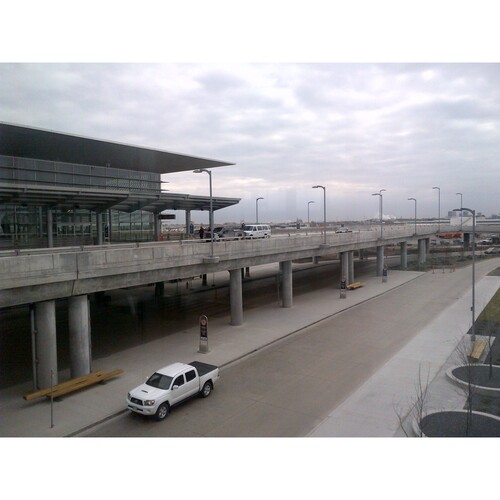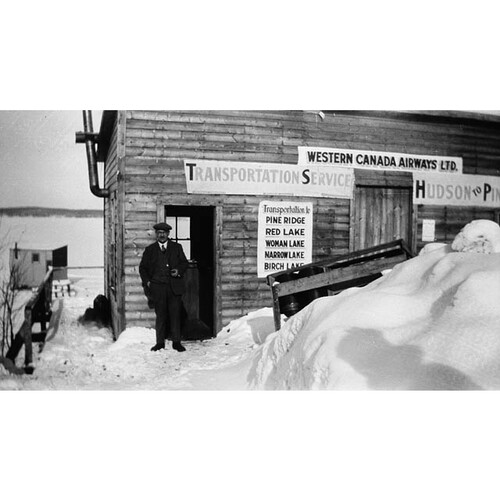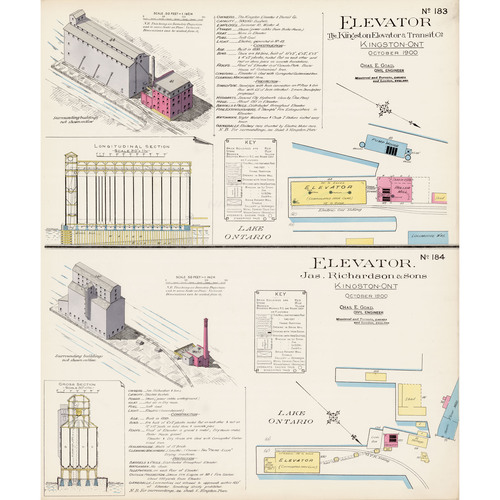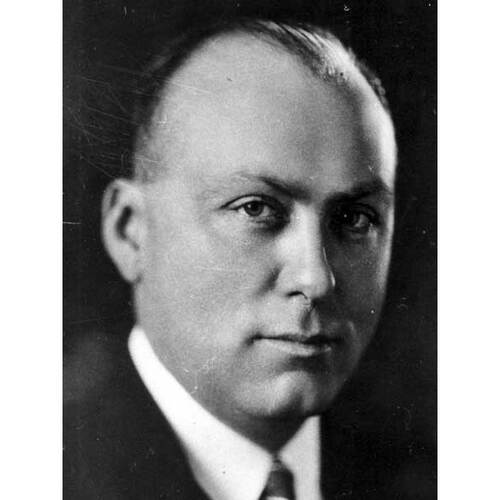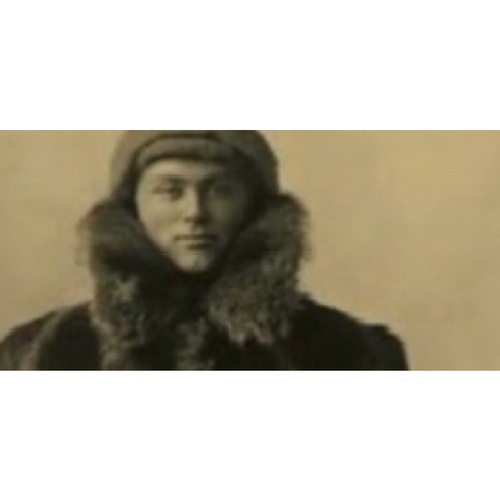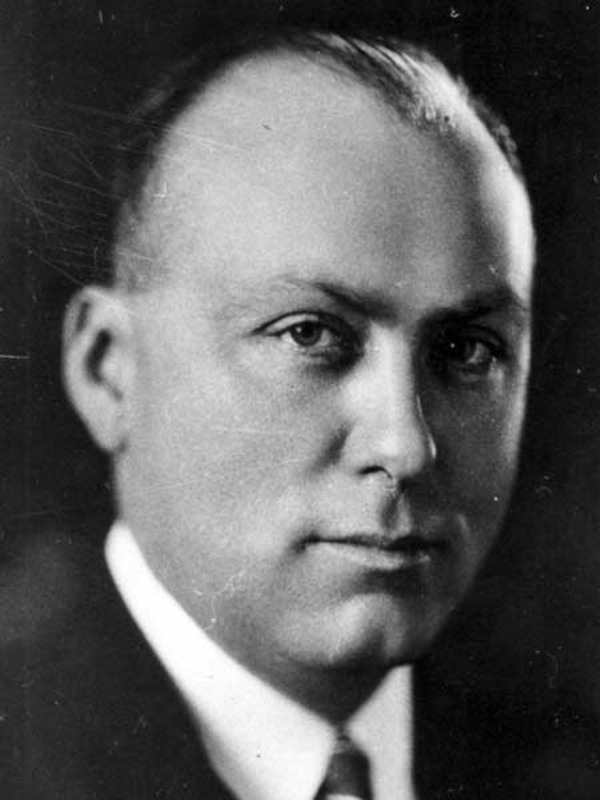
Source: Link
Richardson, James Armstrong, businessman; b. 21 Aug. 1885 in Kingston, Ont., son of George Algernon Richardson and Agnes McCausland; m. 21 May 1919 Annie Muriel Sprague in Belleville, Ont., and they had two sons and two daughters; d. 26 June 1939 in Winnipeg.
James Richardson – Jimmy in his youth – along with his younger brother, George Taylor*, was an avid hockey player, and he was only moderately less keen on rugby. After schooling in Kingston at Hillcroft Academy, he entered Queen’s College in 1902 and studied economics, English, and philosophy. He and George graduated in 1906, two months after the death of their father, and they entered the family’s grain-merchandising business. Founded in Kingston in the mid 19th century by their paternal grandfather, James Richardson*, to ship grain, especially barley, from eastern Ontario along the shore of Lake Ontario and to the United States, the firm was then under the leadership of their uncle, Henry Wartman Richardson. James Richardson and Sons included grain-elevator and warehouse operations, transportation and shipping, the marketing of grain, lumber, coal, livestock, and other commodities, and investments in phosphate and feldspar mines north of Kingston, as well as in a number of local factories.
In 1907 James’s involvement with the firm took him to Toronto; the branch office established there ten years earlier was responsible for an area extending from Belleville to Windsor and north to Sudbury. He systematically built up the customer base of millers and seed dealers in central and western Ontario. Although he frequently returned to Kingston, he also began to travel west each year to familiarize himself with the rapidly expanding prairie-grain trade that would soon dominate his business operations.
In December 1909 James Richardson and Sons Limited was incorporated with a capital stock of $750,000. At the first meeting of its provisional directors, on 1 Jan. 1910, Richardson became vice-president. Two years later, to represent its commercial interests more effectively, he moved to Winnipeg, where, according to geographer Brian S. Osborne and historian Donald Wayne Swainson, the firm would become “a central institution” and “a crucial force in the evolution of the prairie economy.” In charge of its western offices, in 1913 Richardson also became president of the Pioneer Grain Company Limited, a wholly owned subsidiary that provided a distinct organizational structure for the business’s almost 30 country elevators.
The death of his brother George during World War I profoundly affected Richardson. In the words of historian Donald Grant Creighton*, Richardson “hoped, as far as this was possible, to live two lives instead of one.” His friends (and government officials who emphasized his importance in ensuring the delivery of foodstuff in support of the war effort) had difficulty dissuading him from enlisting. But he heeded their advice and instead contributed to the Allied cause by advising governments on the purchase and shipment of North American grain. The British royal commission on wheat supplies, established in October 1916 to control the purchase of wheat and flour, was soon acting for France, Italy, and other nations. Richardson’s knowledge of the trade and his reputation for integrity were such that on 1 Feb. 1918, at the joint request of buyers working for the commission and representatives of eastern milling firms, he took charge of wheat distribution to 284 mills in central and eastern Canada. Shortly afterwards, he was asked to assume the vice-presidency of the Wheat Export Company Limited, which the commission had created as its sole grain-purchasing agency in Canada.
In March 1919 James became president of James Richardson and Sons Limited after the death of Henry Wartman Richardson the previous October. In that office, and in many of the roles he would assume, he demonstrated an extraordinary mastery of details – grain prices, rail and shipping rates, brokerage charges, insurance levies, and weather conditions – and comprehended their significance. He presided successfully over the evolution of a business, supported by dozens of foreign correspondents, that delivered Canadian grain from terminal facilities in Vancouver, Port Arthur (Thunder Bay), Ont., Kingston, and Montreal to customers around the world. Richardson’s unparalleled understanding of this vital industry made him a valuable adviser to royal commissions and other government bodies because the management of grain marketing and Canadian interests in the competitive world trade developed significantly during the post-war period.
In 1919 the Canadian Board of Grain Supervisors, which had exercised control over grain transport, pricing, and distribution during wartime, gave way to a short-lived Canadian Wheat Board, which assumed direct authority for selling the crop. Richardson participated in ongoing deliberations about the Canadian grain-marketing framework, a debate that intensified when wheat prices fell sharply with the declining demand for the North American crop and the resumption of European production. He argued forcefully against government marketing, stating in 1922, for example, that “if we propose to sell wheat for export we must realize that we must produce against the world, and that the buyer … is interested only in the price and the quality. To try to boost the Canadian wheat price above its value in the world’s market would get us nowhere. We would only be holding an umbrella for wheat producers in other countries to sit under, and we would be encouraging production in other countries instead of our own.” During his presidency of the Winnipeg Grain and Produce Exchange in 1923–24, he chaired a committee that made representations to the federal government arguing against its proposal to reconstitute the national wheat board as a permanent body. Despite these efforts, the board would eventually be set up in 1935.
Richardson’s marriage in May 1919 to Muriel Sprague had brought him companionship and understanding; she would soon become a business confidante. After his death she would be prepared and determined to take charge of the increasingly complex and diverse business interests that her husband had pursued.
Following a corporate reorganization in 1923 and the move of the head office from Kingston to Winnipeg, Richardson led the family firm into several new ventures. The central importance of current information and effective communication in grain merchandising had been acknowledged by his company in its wartime use of a private telegraph system offering direct links to Chicago and New York. This arrangement, supplemented by special services to farm customers over commercial networks, was strengthened by a wire-sharing arrangement with the Winnipeg offices of E. A. Pierce and Company, a New York stock-brokering firm. These practical initiatives led Richardson to enquire into emerging forms of wireless communication, both short-wave and AM radio broadcasting. In 1925 he obtained transmitters from the Canadian Marconi Company for experimental broadcasts, initially from the grain-exchange building in Winnipeg. During the next few years Richardson oversaw the development of a small chain of radio stations in western Canada to air children’s programs, musical performances, and information on current affairs and grain prices. In addition to CJRO/CJRX, operating from Middlechurch, near Winnipeg, the network included the Saskatchewan stations CJRM in Moose Jaw, CJRW in Fleming, and CJGX in Yorkton.
In 1926 James Richardson and Sons Limited established a wholly owned financial subsidiary to handle western Canadian clients’ investments in stocks and bonds. The following year the investment branch took over the local offices of the Pierce brokerage firm and its telegraph system. By 1929 it had offices in Edmonton, Moose Jaw, Saskatoon, Brandon, Winnipeg, Toronto, Kingston, and Montreal, all connected by private telegraph to major stock, mining, and grain exchanges in Canada and the United States. In addition to providing services, the subsidiary helped to support the costs of a communication system that had become an integral part of the grain business.
By the early 1920s, in addition to the international grain trade that was his primary interest, Richardson was pursuing numerous other activities either as a senior operating executive or as a director of major enterprises. For example, he was vice-president of the Great Lakes Transportation Company, a firm he had set up with businessman James Playfair. He was named a director of the Canadian Bank of Commerce in 1920, the Canadian Pacific Railway in 1927, and the International Nickel Company in 1928. In December 1927 he became a member of the Canadian committee of the Hudson’s Bay Company.
Richardson’s affection for Queen’s, nourished by his own undergraduate experience, had deepened with time. To honour the memory of his younger brother, he had donated funds for the erection of the George Taylor Richardson Memorial Stadium, which opened in 1921. Additional donations were made for the university gymnasium and the study of international relations. In 1922 he was appointed a trustee. On 11 Oct. 1929 he succeeded Sir Robert Laird Borden as chancellor.
By the mid 1920s Richardson had become passionately engaged in commercial aviation. His leadership and dedication gave his business the proportions of a mission and would lead to his being regarded by aviation historian Shirley Render as the “Father of Canadian Aviation.” While Canadian government officials had continued to emphasize the military applications of aviation following World War I, Richardson recognized its commercial possibilities, including northern exploration and freight transport, mail delivery, and interurban and ultimately intercontinental passenger travel.
The first stage in Richardson’s personal quest to enhance Canadian air services centred on Western Canada Airways Limited, a company he created in December 1926. Growing at a phenomenal pace, by 1929 WCA was second only to Imperial Airways Limited among air-transport companies in the British empire. Fifty-one single-engine aircraft, often piloted by war veterans or skilled bush fliers such as Harold Anthony (Doc) Oaks, Clennell Haggerston (Punch) Dickins*, Wilfrid Reid (Wop) May*, Wilfred Leigh Brintnell, and Frederick Joseph Stevenson*, provided services, especially cargo transport, throughout the Canadian northwest. Richardson was involved in all aspects of the WCA project: financing the operations, selecting equipment to suit unique Canadian conditions, choosing personnel, and issuing security directives. He made enquiries throughout the aviation industry to develop the same strategic understanding of the business that characterized his appreciation of the international grain trade.
To facilitate expansion at the national level, in 1929 Richardson collaborated in the formation of a syndicate to acquire eastern Canadian aviation companies. The syndicate set up the Aviation Corporation of Canada in July to hold its acquisitions. Working with Sir Henry Worth Thornton, representing the Canadian National Railways, and Edward Wentworth Beatty* of the CPR, Richardson brought various interests together to establish Canadian Airways Limited in 1930. The new venture took over the assets of WCA and the Aviation Corporation of Canada; Richardson became president and acting general manager. He soon formulated a comprehensive vision for air services in Canada, reflecting an astute understanding of technological innovation, logistical detail, and the international context. He was concerned with Canadian sovereignty in aviation, with the emerging challenges of international competition, and with the strategic interests of western and northern Canada in this rapidly expanding sector. The country’s early commercial services depended to a significant degree on revenues from airmail contracts to underpin regular service. Yet political indecisiveness, bureaucratic rivalries, and the Great Depression rendered these contracts highly uncertain and contributed to the precariousness of commercial operations throughout the 1930s. The cancellation of government mail contracts in 1932 and a series of restrictions introduced by federal officials such as Peter Thomas Coolican, acting deputy postmaster general, and General Andrew George Latta McNaughton*, army chief of staff (who was also responsible for civil aviation), frustrated Richardson and gradually undermined Canadian Airways. Both Coolican and McNaughton lacked understanding of the operational and financial aspects of commercial air services.
In 1936 the supervision of civil aviation was transferred from the Department of National Defence to the recently established Department of Transport under minister Clarence Decatur Howe*. When interests from outside the country sought to establish passenger routes in Canada, Canadian authorities contemplated a national air-transport system to safeguard the country’s interests. Howe gave Richardson reason to believe that Canadian Airways Limited would constitute “the backbone” of a new national framework. Indeed, on several occasions the minister confirmed that Canadian Airways would be “the chosen instrument” for establishing a national airline.
Ultimately, relying on Canadian Airways’s business plan and many of the company’s key personnel, Howe formed a government-controlled organization, Trans-Canada Air Lines, in 1937. Richardson was deeply disappointed by the overall course of events, and in particular by Howe’s betrayal. The minister’s personal assurances of government support for Canadian Airways in a national air service had proved unreliable. Howe’s personal ambition and his desire to see the government play a greater role in the airline had shut out Richardson and others. Arguably, however, Richardson’s sense of decency and his reluctance to protest publicly or through legal means left Canadian Airways more vulnerable than it might otherwise have been.
Although a vigorous man, Richardson experienced several worrisome episodes of illness or exhaustion usually attributed by his medical advisers to stress. He died suddenly on 26 June 1939. His widow would preside over a wide array of business interests for almost 30 years.
John Edward Hammell, a pioneer of Canadian mining, spoke of James Armstrong Richardson as a businessman who “didn’t just talk about things. He did them.” Charlotte Elizabeth Hazeltyne Whitton*, a family friend and author of an unpublished biography of Richardson, asserted that he had “spent his increasing wealth with vision and determination to retain and expand existing means of profitable earning for Canadian men and money, and to open and assure new ones.” She ranked him “among the real builders of Canada.” According to the Winnipeg Free Press, he would be remembered for “a transparent honesty … as rare as it was fine and simple; and it was reinforced by candor, by kindness and by courage.”
Information on James Armstrong Richardson can be found in the archives of James Richardson and Sons Limited (Winnipeg), where Donald Grant Creighton’s untitled and unpublished biography of Richardson is held, together with Charlotte Elizabeth Hazeltyne Whitton’s “The western liberties: an unpublished biography of James A. Richardson, 1885–1939” (n.p., 1946). The James Richardson fonds at QUA consists of microfilm copies of originals held by James Richardson and Sons Limited.
AO, RG 80-2-0-250, no.9877; RG 80-5-0-1070, no.13949. Financial Post (Toronto), 2 April 1926, 7 Oct. 1927, 27 June 1929. Globe, 27 June 1939. Robert Bothwell and William Kilbourn, C. D. Howe: a biography (Toronto, 1979). Canadian annual rev., 1927–31. “The late James Armstrong Richardson,” Queen’s Rev. (Kingston, Ont.), 13 (1939): 147–49. B. S. Osborne and Donald Swainson, Kingston: building on the past (Westport, Ont., 1988). Shirley Render, Double cross: the inside story of James A. Richardson and Canadian Airways (Vancouver and Toronto, 1999). M. W. Sharp, “Allied wheat buying in relationship to Canadian marketing policy, 1914–18,” Canadian Journal of Economics and Political Science (Toronto), 6 (1940): 372–89.
Cite This Article
Jamie Benidickson, “RICHARDSON, JAMES ARMSTRONG,” in Dictionary of Canadian Biography, vol. 16, University of Toronto/Université Laval, 2003–, accessed April 29, 2025, https://www.biographi.ca/en/bio/richardson_james_armstrong_16E.html.
The citation above shows the format for footnotes and endnotes according to the Chicago manual of style (16th edition). Information to be used in other citation formats:
| Permalink: | https://www.biographi.ca/en/bio/richardson_james_armstrong_16E.html |
| Author of Article: | Jamie Benidickson |
| Title of Article: | RICHARDSON, JAMES ARMSTRONG |
| Publication Name: | Dictionary of Canadian Biography, vol. 16 |
| Publisher: | University of Toronto/Université Laval |
| Year of revision: | 2013 |
| Access Date: | April 29, 2025 |


